
MIDEAST IN THE MIDWEST
Arabs, others feel overlooked, undercounted
1/19/2014
Bahaa Hariri, co-owner of the Middle East Market on Dorr Street, estimated there are 1,000 to 1,500 Arab-American families in Toledo.
THE BLADE/JEREMY WADSWORTH
Buy This Image
Today, The Blade begins a special project — Mideast in the Midwest — to document the people in the Toledo area who trace their heritage to the Greater Middle East, a region extending from Morocco in the west to Afghanistan in the east, Turkey in the north to Yemen and the Horn of Africa in the south.
This project is in large part a census, but it is also an online oral history, and at its heart is a multitude of rich stories about people who trace their history in Toledo not only in years, but in decades.
The purpose of the survey, which can be found online at mideastmidwest.com, is to attain the best possible estimate of the size and key characteristics of the local Middle Eastern and North African community. The survey will also be distributed to local organizations and religious institutions.
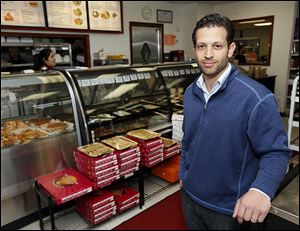
Bahaa Hariri, co-owner of the Middle East Market on Dorr Street, estimated there are 1,000 to 1,500 Arab-American families in Toledo.
First in an occasional series
Ask Khouloud Smaili, 43, owner of Toledo Market, a Middle Eastern grocery on Dorr Street, how many Middle Eastern people live in Toledo and she’ll say likely anywhere between 15,000 and 20,000, based on the volume of customers in her store and orders from the community.
“It’s like you’re living in a village in Lebanon,” Mrs. Smaili said.
But Bahaa Hariri, 26, co-owner of Middle East Market farther west on Dorr, estimates the Arab-American population alone stands at 1,000 to 1,500 families, with an average of three to four people per family.
Mr. Hariri, who has operated his grocery and deli for eight years, said he compares the Toledo Arab community to Dearborn, Mich., but sees little in common in terms of size. The Detroit suburb is home to more than 38,000 people of Arab descent, accounting for nearly 40 percent of its population.
“I think there’s a noticeable increase [in Toledo’s Middle Eastern population],” Mr. Hariri said. “But not necessarily a boom in Toledo.”
Six thousand? Ten thousand? Fifteen thousand? No one, let alone the U.S. Census Bureau, knows how many people in the Greater Toledo area were born in the Middle East or were born to parents or grandparents from the Middle East.
The discrepancy stems from the U.S. government not including people of Middle Eastern and North African descent in their own racial or ethnic category on the decennial U.S. Census and other government documents.
SURVEY: Click here for an electronic version of the Mideast in the Midwest survey.
RELATED LINK: A guide to key terms.
RELATED LINK: Frequently Asked Questions
PROJECT SITE: Mideast in the Midwest
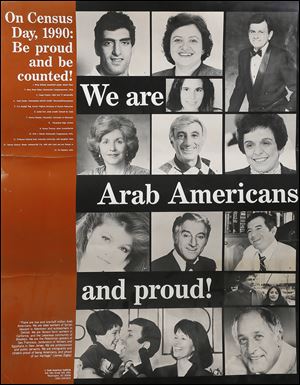
A 1990 poster called attention to the fact that the U.S. Census does not specifically count certain groups, such as Arab-Americans. In the poster, top from left, are Rony Seikaly, then a basketball player for the Miami Heat; Mary Rose Oakar, a congressman from Cleveland; Casey Kasem, radio and TV personality; Kate Karam, Greenpeace activist; Eva Sayegh Teig, former Virginia secretary of human resources; Jamie Farr, actor and Toledo native; Donna Shalala, then chancellor at the University of Wisconsin; Khrystyne Haje, actress; Danny Thomas, an actor who grew up in Toledo; Nick Rahall, congressman from West Virginia; Professor Edward Said of Columbia University, with his daughter Najla; Tommy Hazouri, then mayor of Jacksonville, Fla., with his wife Carol and son Tommy, Jr.; and Vic Tayback, actor.
Lack of subgroups
The U.S. Office of Management and Budget 1997 standards classify people of Middle Eastern and North African descent as white. The language of the federal guidelines on race reads as follows: “White: A person having origins in any of the original peoples of Europe, the Middle East, or North Africa.”
On the 2010 Census, and on past census forms, the question on race included a box for “white.” But this box did not include an option for different subgroups — European, Middle Eastern, and North Africans — classified as white.
Following the box for white on the 2010 Census are separate boxes for the following races: Black, African-American, or Negro; American Indian or Alaska Native; Asian Indian, Chinese, Filipino, Japanese, Korean, Vietnamese, Native Hawaiian, Guamanian or Chamorro, Samoan, Other Pacific Islander, and Other Asian; and “some other race,” with a space for the respondent to write in his preferred identity.
Above the race category, in its own section, is a question about Spanish, Hispanic, and Latino ancestry.
Nowhere on the form have people of Middle Eastern and North African descent been represented, besides an ancestry question on the now-defunct long form census, which listed “Lebanese” as an example of a possible fill-in answer.
Maya Berry, executive director of the Washington-based Arab American Institute, said the issue of white versus nonwhite is subjective and that ethnicity is a better way to measure the different groups within the country.
As for herself, Ms. Berry said, “I have never checked off ‘white’ in my life. I have always checked off ‘other.’ ”
Roberto Ramirez, chief of the Census Bureau’s Ethnicity and Ancestry Statistics Branch in the Population Division, said most people of Middle Eastern or North African ancestry either identify as “white” or “some other race,” when filling out the census.
“You have to keep in mind how the question [on race] was designed,” Mr. Ramirez said. “In all honesty, the question was not designed to capture people of [Middle Eastern and North African] background and descent.”
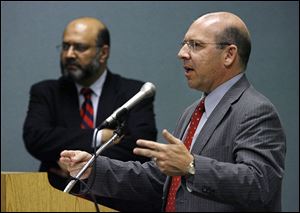
Nadeem Salem, founder of the Network of Arab-American Professionals’ Toledo chapter, says information compiled from The Blade’s survey will help the Middle Eastern and North African community in Greater Toledo understand more about itself.
Undercounted?
This has led to what many in the Middle Eastern and North African community consider an undercount of their population in the United States, Ms. Berry said. “We have been dramatically undercounted for years. It’s an issue of the way folks self-identify.”
According to Mr. Ramirez, officials at the agency do not feel they have undercounted any particular group, but they have been searching for ways to obtain a better count of the Middle Eastern and North African demographic on the 2020 Census.
“There is a demand and there is a request for this category, because they feel they are being undercounted, if you will,” Mr. Ramirez said. “Many respondents from the [Middle Eastern and North African] background don’t identify themselves as white, racially.”
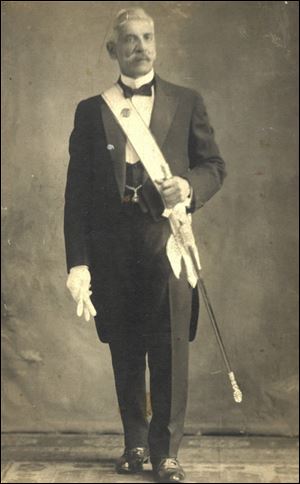
In 1881, Michael Habib Nassr became the first Arab to settle in Toledo. He originally came from the village of Bishara in Lebanon. This undated photo was taken around the turn of the century. He is wearing a Knights of Columbus sash and sword. In Toledo, he owned a wholesale fruit and produce store.
Census estimates
Though the official census form does not directly count people of Middle Eastern and North African descent, the Census Bureau has still released estimates of the group’s population, derived from the former long form census questionnaires and the American Community Survey, a monthly questionnaire that replaced the long form after the 2000 census.
The survey asks an open-ended ancestry question, on which respondents are able to write in their preferred identity.
“Some people go back 500 years. Some people go back to their grandparents,” Mr. Ramirez said.
A May, 2013, Census Bureau report based on American Community Survey numbers from 2006 to 2010 states that the estimated population of Americans with Arab ancestry in the United States stands at 1.5 million, or 0.5 percent of the United States’ population. That number is up from an estimated 1.2 million people reporting Arab ancestry on the 2000 Census.
Arab was the largest Middle Eastern and North African ancestry reported in the United States as of 2012, surpassing Iranian (453,999), Turkish (190,070), Israeli (136,321), Somalian (111,751), Assyrian/Chaldean/Syriac (98,876), and Afghan (86,338).
The Arab American Institute, which adjusts for the so-called undercount by accounting for other indicators, such as immigration data, places the national figure of Arab-Americans at 3.7 million, more than double the government’s estimate.
In 2011, the institute ranked Ohio eighth among states in regard to Arab-American population, with an institute-adjusted estimate of 197,439 people of Arab descent — exactly three times the American Community Survey’s 2005 to 2009 estimate of 65,813 in Ohio. The Arab American Institute did not provide a breakdown by county or municipality, based on its adjustment.
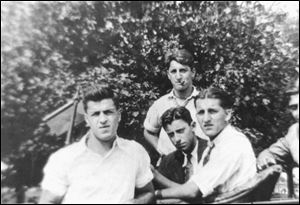
A 1936 image shows Toledoan and Lebanese-American Danny Thomas, then known as Amos Jacob, background, with friends, from left, Joe Abrass, Deke Sodd, and Alex Turbey.
Local figures
Based on the most recent five-year estimate released in 2012, the survey put Lucas County’s Arab population at 6,245, or 1.4 percent of the county’s population. Combining the latest American Community Survey figures for an eight-county region — Lucas, Wood, Ottawa, Sandusky, Hancock, Fulton, Monroe, and Lenawee — the number of people claiming Arab descent stands at 8,873 individuals, or 0.9 percent of the counties’ combined population.
That is down from the estimated 9,600 people of Arab descent in Toledo cited in a 1959 study that focused predominantly on Arab Muslims in Toledo and Detroit. The author of the study, Northern Illinois University professor Abdo Elkholy, estimated that Toledo was home to 8,400 Syrian Christians and 1,200 Arab Muslims in the late 1950s.
When Mr. Elkholy’s numbers are compared with those of the American Community Survey, it shows the area’s Arab-American population has dropped by more than 7 percent.
Nicholas Jones, Census Bureau chief of racial statistics, said the American Community Survey was designed to capture characteristics, not official counts, of demographic groups.
“The strongest count comes from the decennial census because it’s a 100 percent enumeration,” Mr. Jones said. “The American Community Survey, while it provides those benchmarks, they’re just estimates.”

Important data
Nadeem Salem, founder of the Network of Arab-American Professionals’ Toledo chapter, said the Arab-American community in Toledo tried to organize a count in the mid to late 1990s, but the grassroots effort did not come to fruition. He cited project costs and labor commitments as obstacles.
Mr. Salem, who helped The Blade organize its survey, said the idea of prior community census efforts was to create a directory of who was in the community and what their occupations were. The Blade’s survey will not ask for names or identification information. It will be completely anonymous.
Mr. Salem, who is a financial adviser and chairman of the Toledo-Lucas County Port Authority, said the information and data compiled from The Blade’s survey would help the Middle Eastern and North African community in Greater Toledo understand more about itself.
“I think we dilute our numbers and our influence in a community if nobody really knows what our numbers are,” Mr. Salem said.
He said the number of Arab-Americans alone stands anywhere between 10,000 to 15,000, citing the high number of congregants at the local mosques during holiday prayers.
“I think, generally, those of us who have been in the community, we know that this community has grown dramatically over the past two or three decades,” Mr. Salem said.
Gaby Semaan, director of the Middle East Studies program at the University of Toledo, said that through his research he has come across an estimate of 15,000 Arab-Americans in Greater Toledo.
Mr. Semaan, who has also helped The Blade with its survey, has conducted research for a forthcoming paper and has sent out questionnaires in the Arab-American communities of 13 states, mainly focusing on Toledo, Detroit, and Allentown, Pa. The questionnaires solicit information on cultural identity and acculturation of different Arab groups.
He said the 15,000 figure for Arab-Americans locally is not a big stretch, but it is still just an estimate.
“Up until now, I don’t think anyone has that number,” he said. “Up until now, I don’t think we have an accurate figure.”
Contact Hasan Dudar at: hdudar@theblade.com or 419-724-6082.